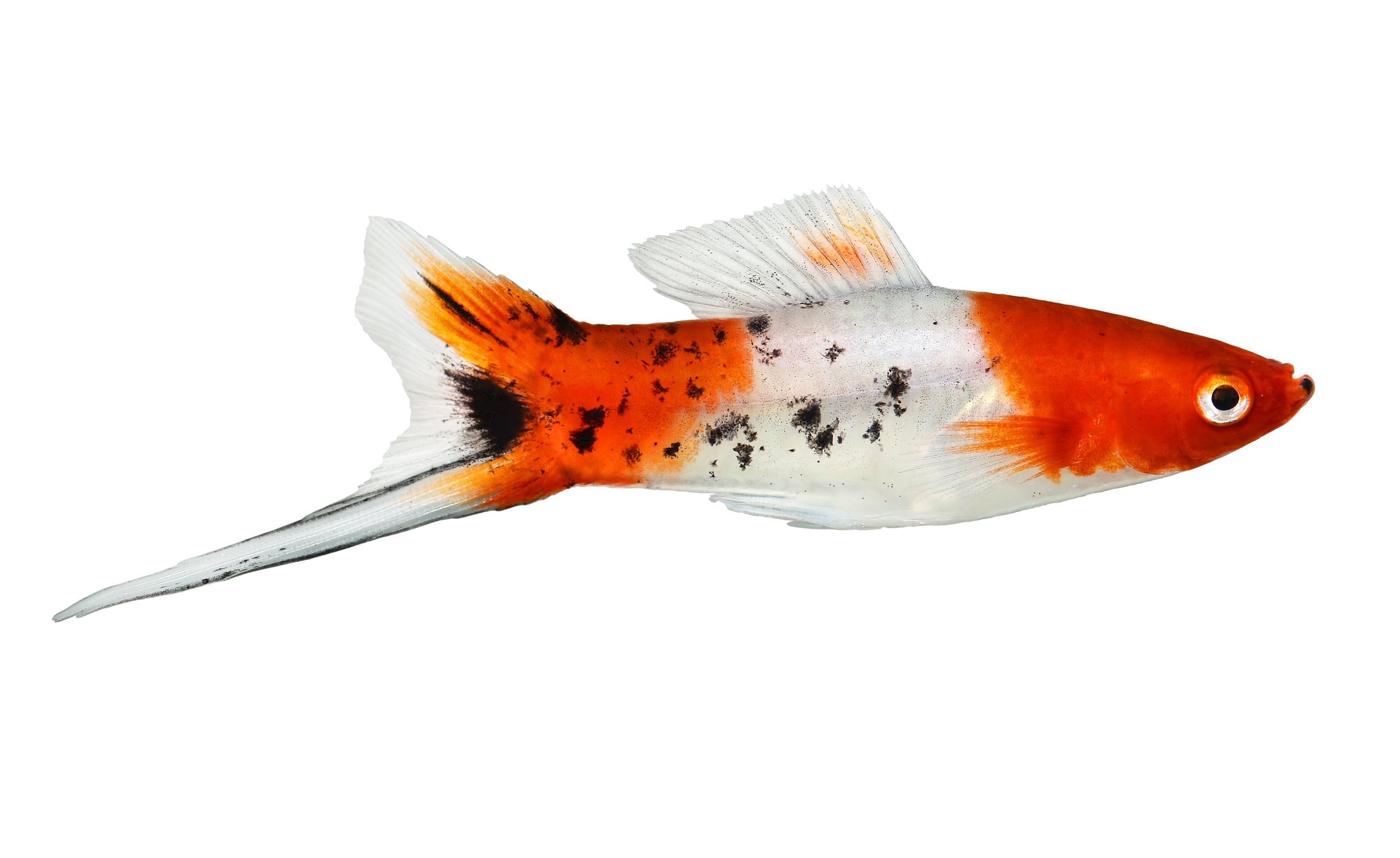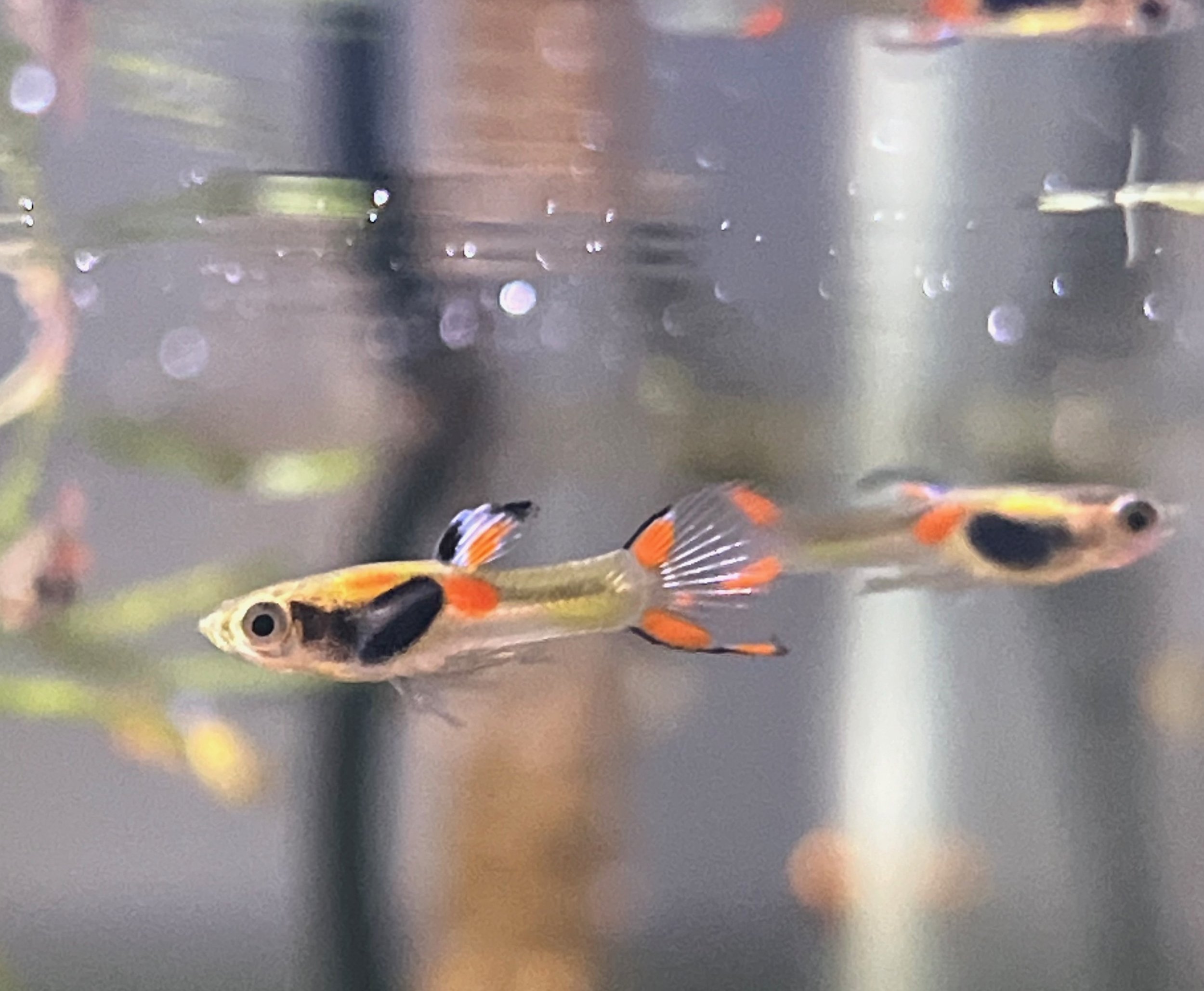 Image 1 of 2
Image 1 of 2

 Image 2 of 2
Image 2 of 2



Koi Swordtails
Swordtails, scientifically known as Xiphophorus hellerii, are a popular and versatile freshwater fish species native to Central America, particularly Mexico, Guatemala, and Honduras. Renowned for their vibrant colors, distinctive sword-like extension on the lower part of their tails (in males), and ease of care, swordtails are a favorite among aquarists of all experience levels.
Physically, swordtails exhibit a streamlined body shape with a slightly flattened profile. Their coloration varies widely, ranging from vibrant shades of red, orange, yellow, and green to more subdued hues such as black, silver, and white. Additionally, males typically feature a distinctive elongated extension on the lower part of their tails, resembling a sword, which is absent in females. Mature swordtails can reach lengths of up to 2.5 to 4 inches (6 to 10 centimeters), with males often being slightly smaller than females.
In aquariums, swordtails are prized for their active and peaceful nature, making them excellent community fish. They thrive in well-maintained tanks with plenty of swimming space and hiding spots provided by plants, rocks, and driftwood. Swordtails are also known for their adaptability to a wide range of water parameters, although they prefer slightly alkaline to neutral pH levels between 7.0 to 8.0 and water temperatures ranging from 72 to 82°F (22 to 28°C).
Feeding swordtails is relatively straightforward, as they are omnivorous and will accept a varied diet. High-quality flake or pellet food serves as a staple, supplemented with occasional offerings of live or frozen foods such as bloodworms, brine shrimp, and daphnia to enhance their diet and promote optimal health and coloration. Additionally, providing vegetable matter in the form of blanched spinach or algae-based foods ensures their nutritional needs are met.
Breeding swordtails in captivity is relatively easy, and they are known for their prolific breeding habits. Males use their sword-like extensions to court females, and mating typically occurs after a brief courtship display. Once mating is successful, females give birth to live young after a gestation period of around 4 to 6 weeks. Fry are born fully formed and capable of swimming and feeding immediately, making them relatively easy to care for and raise.
Overall, swordtails are a delightful and versatile addition to freshwater aquariums, prized for their beauty, ease of care, and peaceful temperament. Whether kept in a species-specific setup or a community tank, these charismatic fish bring vibrancy, activity, and joy to any aquatic environment, making them a cherished choice among aquarists worldwide.
Swordtails, scientifically known as Xiphophorus hellerii, are a popular and versatile freshwater fish species native to Central America, particularly Mexico, Guatemala, and Honduras. Renowned for their vibrant colors, distinctive sword-like extension on the lower part of their tails (in males), and ease of care, swordtails are a favorite among aquarists of all experience levels.
Physically, swordtails exhibit a streamlined body shape with a slightly flattened profile. Their coloration varies widely, ranging from vibrant shades of red, orange, yellow, and green to more subdued hues such as black, silver, and white. Additionally, males typically feature a distinctive elongated extension on the lower part of their tails, resembling a sword, which is absent in females. Mature swordtails can reach lengths of up to 2.5 to 4 inches (6 to 10 centimeters), with males often being slightly smaller than females.
In aquariums, swordtails are prized for their active and peaceful nature, making them excellent community fish. They thrive in well-maintained tanks with plenty of swimming space and hiding spots provided by plants, rocks, and driftwood. Swordtails are also known for their adaptability to a wide range of water parameters, although they prefer slightly alkaline to neutral pH levels between 7.0 to 8.0 and water temperatures ranging from 72 to 82°F (22 to 28°C).
Feeding swordtails is relatively straightforward, as they are omnivorous and will accept a varied diet. High-quality flake or pellet food serves as a staple, supplemented with occasional offerings of live or frozen foods such as bloodworms, brine shrimp, and daphnia to enhance their diet and promote optimal health and coloration. Additionally, providing vegetable matter in the form of blanched spinach or algae-based foods ensures their nutritional needs are met.
Breeding swordtails in captivity is relatively easy, and they are known for their prolific breeding habits. Males use their sword-like extensions to court females, and mating typically occurs after a brief courtship display. Once mating is successful, females give birth to live young after a gestation period of around 4 to 6 weeks. Fry are born fully formed and capable of swimming and feeding immediately, making them relatively easy to care for and raise.
Overall, swordtails are a delightful and versatile addition to freshwater aquariums, prized for their beauty, ease of care, and peaceful temperament. Whether kept in a species-specific setup or a community tank, these charismatic fish bring vibrancy, activity, and joy to any aquatic environment, making them a cherished choice among aquarists worldwide.
Swordtails, scientifically known as Xiphophorus hellerii, are a popular and versatile freshwater fish species native to Central America, particularly Mexico, Guatemala, and Honduras. Renowned for their vibrant colors, distinctive sword-like extension on the lower part of their tails (in males), and ease of care, swordtails are a favorite among aquarists of all experience levels.
Physically, swordtails exhibit a streamlined body shape with a slightly flattened profile. Their coloration varies widely, ranging from vibrant shades of red, orange, yellow, and green to more subdued hues such as black, silver, and white. Additionally, males typically feature a distinctive elongated extension on the lower part of their tails, resembling a sword, which is absent in females. Mature swordtails can reach lengths of up to 2.5 to 4 inches (6 to 10 centimeters), with males often being slightly smaller than females.
In aquariums, swordtails are prized for their active and peaceful nature, making them excellent community fish. They thrive in well-maintained tanks with plenty of swimming space and hiding spots provided by plants, rocks, and driftwood. Swordtails are also known for their adaptability to a wide range of water parameters, although they prefer slightly alkaline to neutral pH levels between 7.0 to 8.0 and water temperatures ranging from 72 to 82°F (22 to 28°C).
Feeding swordtails is relatively straightforward, as they are omnivorous and will accept a varied diet. High-quality flake or pellet food serves as a staple, supplemented with occasional offerings of live or frozen foods such as bloodworms, brine shrimp, and daphnia to enhance their diet and promote optimal health and coloration. Additionally, providing vegetable matter in the form of blanched spinach or algae-based foods ensures their nutritional needs are met.
Breeding swordtails in captivity is relatively easy, and they are known for their prolific breeding habits. Males use their sword-like extensions to court females, and mating typically occurs after a brief courtship display. Once mating is successful, females give birth to live young after a gestation period of around 4 to 6 weeks. Fry are born fully formed and capable of swimming and feeding immediately, making them relatively easy to care for and raise.
Overall, swordtails are a delightful and versatile addition to freshwater aquariums, prized for their beauty, ease of care, and peaceful temperament. Whether kept in a species-specific setup or a community tank, these charismatic fish bring vibrancy, activity, and joy to any aquatic environment, making them a cherished choice among aquarists worldwide.





